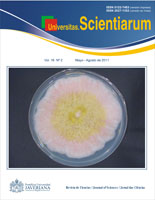Abstract
Objective. To determine the presence of NoVs as a possible causal zoonotic agent of acute diarrhea in pigs and humans. Materials and methods. We collected a total of 77 samples from diarrheal children under 5 years and pigs under 2 months from La Chamba town in Tolima, Colombia. These samples were transported to the Laboratory of Virology of the Pontificia Universidad Javeriana in Bogotá, and extraction with Trizol-reagent was done following the manufacturer's instructions. After obtaining the RNA, the next step was to perform RT-PCR for obtaining the expected amplification product of 213- bp NoVs. Finally, the positive samples obtained in the RT-PCR were sequenced and analyzed by bioinformatics methods. Results. Six positive diarrheic samples from children and a positive diarrheic sample from pigs were detected by a band of 231 bp. Five of the six positive samples in children and the positive pig sample were sequenced and analyzed. Conclusion. Given the close genetic relationship between pig and human sequences, this could be an indication of the potential existence of a common animal acting as a reservoir for human or other animal strains.
Key words: Human Norovirus, domestic pigs, diarrhea, zoonotic transmission, reservoirs
Univ. Sci. is registered under a Creative Commons Attribution 4.0 International Public License. Thus, this work may be reproduced, distributed, and publicly shared in digital format, as long as the names of the authors and Pontificia Universidad Javeriana are acknowledged. Others are allowed to quote, adapt, transform, auto-archive, republish, and create based on this material, for any purpose (even commercial ones), provided the authorship is duly acknowledged, a link to the original work is provided, and it is specified if changes have been made. Pontificia Universidad Javeriana does not hold the rights of published works and the authors are solely responsible for the contents of their works; they keep the moral, intellectual, privacy, and publicity rights. Approving the intervention of the work (review, copy-editing, translation, layout) and the following outreach, are granted through an use license and not through an assignment of rights. This means the journal and Pontificia Universidad Javeriana cannot be held responsible for any ethical malpractice by the authors. As a consequence of the protection granted by the use license, the journal is not required to publish recantations or modify information already published, unless the errata stems from the editorial management process. Publishing contents in this journal does not generate royalties for contributors.



